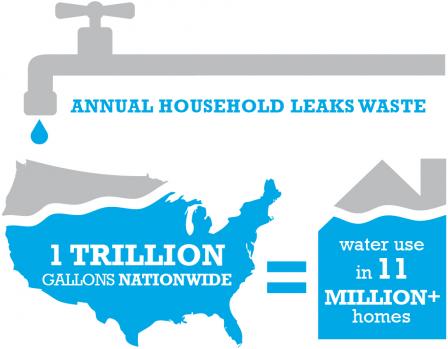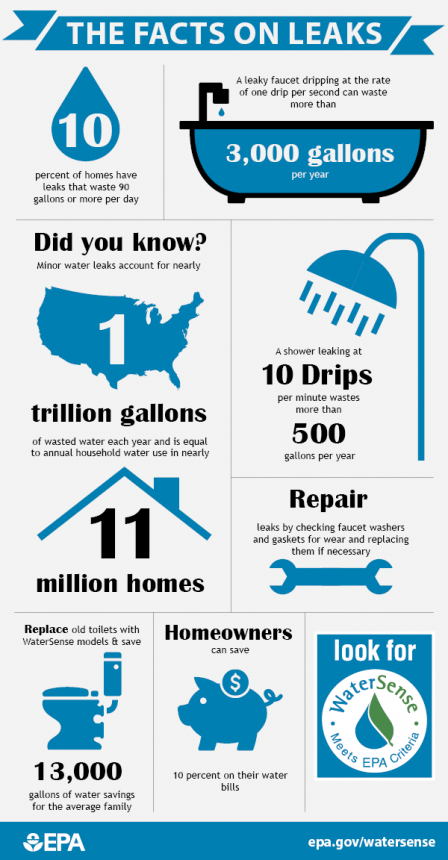Fix a Leak Week
 Leaks Can Run, but They Can't Hide
Leaks Can Run, but They Can't Hide
Are you ready to chase down leaks? Household leaks can waste nearly 1 trillion gallons of water annually nationwide, so each year we hunt down the drips during Fix a Leak Week. Mark your calendars for EPA's annual Fix a Leak Week, March 15 through 21, 2021—but remember that you can find and fix leaks inside and outside your home to save valuable water and money all year long.
From family fun runs to leak detection contests to WaterSense demonstrations, Fix a Leak Week events happen from coast to coast and are all geared to teach you how to find and fix household leaks. See our Event map at the bottom of this page (or on FacebookEXIT) to find events near you and view past events!
Learn how to find and fix leaks during Fix a Leak Week. It's as easy as 1-2-3.
On This Page:
- Checking for Leaks
- Toilet Leaks
- Faucet Leaks
- Showerhead Leaks
- Outdoor Leaks
- In the Workplace
- Leaks Still Flowing?
- Partner Events
Checking for Leaks
 The average household's leaks can account for nearly 10,000 gallons of water wasted every year and ten percent of homes have leaks that waste 90 gallons or more per day. Common types of leaks found in the home are worn toilet flappers, dripping faucets, and other leaking valves. These types of leaks are often easy to fix, requiring only a few tools and hardware that can pay for themselves in water savings. Fixing easily corrected household water leaks can save homeowners about 10 percent on their water bills.
The average household's leaks can account for nearly 10,000 gallons of water wasted every year and ten percent of homes have leaks that waste 90 gallons or more per day. Common types of leaks found in the home are worn toilet flappers, dripping faucets, and other leaking valves. These types of leaks are often easy to fix, requiring only a few tools and hardware that can pay for themselves in water savings. Fixing easily corrected household water leaks can save homeowners about 10 percent on their water bills.
To check for leaks in your home, you first need to determine whether you're wasting water and then identify the source of the leak. Here are some tips for finding leaks:
- Take a look at your water usage during a colder month, such as January or February. If a family of four exceeds 12,000 gallons per month, there are serious leaks.
- Check your water meter before and after a two-hour period when no water is being used. If the meter changes at all, you probably have a leak.
- Identify toilet leaks by placing a drop of food coloring in the toilet tank. If any color shows up in the bowl after 10 minutes, you have a leak. (Be sure to flush immediately after the experiment to avoid staining the tank.)
- Examine faucet gaskets and pipe fittings for any water on the outside of the pipe to check for surface leaks.
- Use our checklist to keep track of your search for leaks: Detect and Chase Down Leaks at Home Checklist (2 pp, 2 MB, About PDF) | En Español (PDF) (2 pp, yy K, About PDF)
- WaterSense partners have guides and videos that you might find helpful in finding and fixing leaks.
- Arizona Municipal Water User's Association has a great Smart Home Water Guide.Exit
- Regional Water Providers Consortium in Oregon has a video on detecting household leaks.Exit
- Thornton Water in Colorado provides tips and tricks to find hidden water waste indoors and outdoors.Exit
Toilet Leaks
Old or worn-out toilet flappers (e.g., valve seal) can cause leaks. Flappers are inexpensive rubber parts that can build up minerals or decay over time. Replacing them can be a quick and easy fix for your water woes. To fix this leak, consult your local hardware store, home improvement retailer, or licensed plumber. Here are some online resources from WaterSense partners:
- WaterSense Bath Hack #3 shows how easy it is to Replace Your Leaky Toilet Flapper.Exit
- Spartanburg Water in South Carolina has a useful video tutorial on detecting leaky toilets.Exit
- Concord General Services has a dye test video on how to detect a toilet leak.Exit
- The Regional Water Providers Consortium has a step-by-step video on how to fix a leaky toilet.Exit
Tip: Bring the old flapper to the hardware store for comparison to make sure you buy a new flapper that fits your toilet model. You can also check the owner's manual, if you have it, or the manufacturer's website for the appropriate replacement part number for the flapper.
Faucet Leaks
 Old and worn faucet washers and gaskets frequently cause leaks in faucets. A leaky faucet that drips at the rate of one drip per second can waste more than 3,000 gallons per year. That's the amount of water needed to take more than 180 showers! Many tutorials are available online for how to fix a wide variety of faucets. Here are a few examples from our partners:
Old and worn faucet washers and gaskets frequently cause leaks in faucets. A leaky faucet that drips at the rate of one drip per second can waste more than 3,000 gallons per year. That's the amount of water needed to take more than 180 showers! Many tutorials are available online for how to fix a wide variety of faucets. Here are a few examples from our partners:
- Lowe's How to Fix a Dripping or Leaky Double Handle Faucet.Exit
- Lowe's How to Fix a Dripping or Leaky Single Handle Faucet.Exit
- The Home Depot How to Fix a Leaky Bathtub Faucet.Exit
- WaterSense Bath Hack #2 shows you How to Replace your Faucet Aerator.Exit
Tip: Don't forget to turn off the water line before you start!
Showerhead Leaks
A showerhead leaking at 10 drips per minute wastes more than 500 gallons per year. That's the amount of water it takes to wash 60 loads of dishes in your dishwasher. Some leaky showerheads can be fixed by making sure there is a tight connection between the showerhead and the pipe stem and by using pipe tape to secure it. Pipe tape, also called Teflon tape, is available at most hardware stores, is easy to apply, and can help control leaks. For more complicated valve leaks in showers that drip when not in use, contact an experienced handyperson or licensed plumber.
- This WaterSense Showerhead Bath Hack #1 video Exitshows how easy it is to add teflon tape and replace your showerhead.
Tip: It's also a good idea to check and, if needed, replace the washer or "o" ring inside the showerhead while making this repair.
Outdoor Leaks
If you have an in-ground irrigation system, check it each spring before use to make sure it wasn’t damaged by frost or freezing. An irrigation system that has a leak 1/32nd of an inch in diameter (about the thickness of a dime) can waste about 6,300 gallons of water per month. If you need help, hire an irrigation professional certified by a WaterSense labeled program to inspect it for you. These professionals have passed a certification program focused on water efficiency. They will not only help you detect and correct leaks in the system, but also maximize its efficiency.
- The Region of Peel in Ontario has a good overview for how to check for sprinkler system leaks. Exit
- The Salt River Project in Arizona has good tips on how to determine if you have a pool leak. Exit
Tip: Don't forget garden hoses! Check your garden hose for leaks at its connection to the spigot. If it leaks while you run your hose, replace the nylon or rubber hose washer and ensure a tight connection to the spigot using pipe tape and a wrench.
In the Workplace
Leaks don’t just don’t happen at home. You should be on the lookout for leaks even when you are at work. Here are some ways to help find and fix leaks in your workplace.
- If you see a leak – in the restroom, pantry, or outdoors, report it to your maintenance staff.
- Organize a Fix a Leak Week event in your facility to challenge employees and tenants to find leaks and report water waste. You may even be able to get your local water utility to help.
- Put up signs in restrooms and pantries to encourage everyone to look for leaks and report problems. Include information on who they should contact. WaterSense has developed some graphic tools you can use to communicate with employees on the need to report leaks.
- Spread the word about saving water to all tenants, as well as cleaning, housekeeping, maintenance, and landscaping staff.
- Use our checklist to keep track of areas to check for leaks: Fight Leaks and Water Waste in your Facility Checklist(2 pp, 638 K, About PDF)
- Interested in knowing more about how to fight leaks and water waste in commercial buildings? We have advice to help you get started.
Leaks Still Flowing?
If you've already determined you have leaks and you find these step-by-step solutions aren't enough to stop them, it might be time to replace your leaking fixtures. When you consult with a plumbing professional, and look for the WaterSense label when considering a new toilet, faucet, or showerhead, you could increase your home's water efficiency. See a complete list of WaterSense labeled products.

